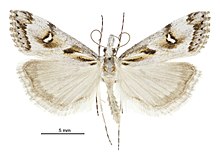Gadira leucophthalma
| Gadira leucophthalma | |
|---|---|

| |
| Male | |
| Scientific classification | |
| Kingdom: | Animalia |
| Phylum: | Arthropoda |
| Class: | Insecta |
| Order: | Lepidoptera |
| Family: | Crambidae |
| Subfamily: | Crambinae |
| Tribe: | Chiloini |
| Genus: | Gadira |
| Species: | G. leucophthalma
|
| Binomial name | |
| Gadira leucophthalma (Meyrick, 1882)
| |
| Synonyms | |
| |
Gadira leucophthalma, commonly known as the beaked moss moth, is a moth in the family Crambidae. It is endemic to New Zealand. This species has been classified as Nationally Vulnerable by the Department of Conservation.
Taxonomy[]
This species was first described by Edward Meyrick in 1882 from specimens collected in the Port Hills near Lyttelton and named Thinasotia leucophthalma.[2] Thinasotia was a misspelling by Meyrick of the genus Thisanotia.[3] Meyrick gave a more detailed description of the species in 1883.[4] In 1895 George Hampson placed this species within the genus Talis.[5] This placement was followed by Meyrick in 1913,[6] George Vernon Hudson in 1928,[7] and in 1930 by Alfred Philpott, who studied the male genitalia of the species.[8] In 1973 assigned the species to the genus Gadira.[9] The lectotype specimen of this moth is held at the Natural History Museum, London.[3]
Distribution[]
G. leucophthalma is endemic to New Zealand.[10][11] Along with its type location of Lyttelton hills, this species has also been collected on Mount Gray,[7] on Kaitorete Spit,[12][13][14] and on Banks Peninsula,[15] all in Canterbury. G. leucophthalma is also recorded as being present at Cloudy Bay.[16]
Description[]
This species is visually very similar to Gadira petraula but it can be distinguished as G. leucophthalma is slightly larger and the edges of its forewings are more lightly coloured.[15] Both G. leucophthalma male and females have variable colour patternation on their wings.[16] The females have variable wing length.[16]
Biology and behaviour[]
Meyrick originally collected adults of the species in March but subsequently took it in December.[17] Specimens have also been collected in November.[7] However it is more commonly seen from March to April.[13] The species is a day flying moth although some specimens have been trapped at night with UV light.[16]
Habitat[]
G. leucophthalma prefers to inhabit foredunes.[13] The species has also been found to inhabit areas of bristle-grass with moss present.[16]
Host plants[]
The host plants of this species is unknown although it has been hypothesised that the larvae feed on moss.[16]
Conservation Status[]
This species has the "Nationally Vulnerable" conservation status under the New Zealand Threat Classification System.[1]
References[]
| Wikimedia Commons has media related to Gadira leucophthalma. |
- ^ a b Hoare, R.J.B.; Dugdale, J.S.; Edwards, E.D.; Gibbs, G.W.; Patrick, B.H.; Hitchmough, R.A.; Rolfe, J.R. (2017). "Conservation status of New Zealand butterflies and moths (Lepidoptera), 2015" (PDF). New Zealand Threat Classification Series. 20: 6.
- ^ Meyrick, Edward (1882). "Descriptions of New Zealand Micro-Lepidoptera (I.)". New Zealand Journal of Science. 1: 186–187 – via Biodiversity Heritage Library.
- ^ a b Dugdale, J. S. (1988). "Lepidoptera-annotated catalogue, and keys to family-group taxa" (PDF). Fauna of New Zealand. 14: 1–264 – via Landcare Research New Zealand Ltd.
- ^ Meyrick, Edward (1883). "Descriptions of New Zealand Micro-Lepidoptera". Transactions and Proceedings of the New Zealand Institute. 15: 3–68. Retrieved 5 May 2018.
- ^ Hampson, George F. (1895). "On the classification of the Schoenobiinae and Crambinae, two subfamilies of moths of the family Pyralidae". Proceedings of the Zoological Society of London. 1895: 897–974. Retrieved 5 May 2018.
- ^ Meyrick, Edward (1913). "A Revision of the New Zealand Pyralidina". Transactions and Proceedings of the New Zealand Institute. 45: 30–51 – via Biodiversity Heritage Library.
- ^ a b c Hudson, G. V. (1928). The Butterflies and Moths of New Zealand. Wellington: Ferguson & Osborn Ltd. p. 172.
- ^ Philpott, Alfred (1930). "The Male Genitalia of the New Zealand Crambidae". Transactions and Proceedings of the Royal Society of New Zealand. 60: 491–514.
- ^ Gaskin, David E. (1973). "Revision of New Zealand Chilonini (Lepidoptera; Pyralidae) and redescription of some Australian species". New Zealand Journal of Science. 16: 435–463.
- ^ "Gadira leucophthalma (Meyrick, 1882)". www.nzor.org.nz. Landcare Research New Zealand Ltd. Retrieved 2017-07-11.
- ^ Gordon, Dennis P., ed. (2010). New Zealand inventory of biodiversity: Kingdom animalia : chaetognatha, ecdysozoa, ichnofossils. 2. p. 457. ISBN 978-1-877257-93-3. OCLC 973607714. OL 25288394M. Wikidata Q45922947.
- ^ Gaskin, David E. (1987). "Supplement to New Zealand Crambinae (Lepidoptera: Pyralidae) — corrections, description of females of two species, and notes on structure, biology, and distribution". New Zealand Journal of Zoology. 14 (1): 113–121. doi:10.1080/03014223.1987.10422688.
- ^ a b c Patrick, Brian (1994). "Lepidoptera of Kaitorete Spit, Canterbury". New Zealand Entomologist. 17: 52–63. CiteSeerX 10.1.1.580.6402. doi:10.1080/00779962.1994.9721985.
- ^ Debbie Hogan, Scott Hooson (6 June 2017). Christchurch District Plan Site of Ecological Significance: Kaitorete Spit (PDF) (Report). Christchurch City Council. p. 7. Retrieved 5 May 2017.CS1 maint: uses authors parameter (link)
- ^ a b "Gadira petraula". Gadira petraula (Meyrick, 1883). Manaaki Whenua - Landcare Research. Retrieved 2018-05-05.
- ^ a b c d e f Dugdale, John S. (2001). Cloudy Bay coastal habitats : entomological values of the foreshore and associated inland habitats (PDF). Nelson, N.Z.: Department of Conservation, Nelson/Marlborough Conservancy. p. 13. ISBN 978-0478220834. OCLC 81750966.
- ^ Meyrick, Edward (1885). "Descriptions of New Zealand micro-lepidoptera". Transactions and Proceedings of the New Zealand Institute. 17: 121–140 – via Biodiversity Heritage Library.
- Crambinae
- Moths described in 1882
- Moths of New Zealand
- Taxa named by Edward Meyrick
- Endemic fauna of New Zealand
- Endangered biota of New Zealand
- Crambinae stubs
